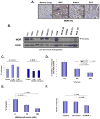The novel role of the mu opioid receptor in lung cancer progression: a laboratory investigation
- PMID: 21156980
- PMCID: PMC4327979
- DOI: 10.1213/ANE.0b013e31820568af
The novel role of the mu opioid receptor in lung cancer progression: a laboratory investigation
Abstract
Background: The possibility that μ opioid agonists can influence cancer recurrence is a subject of recent interest. Epidemiologic studies suggested that there were differences in cancer recurrence in breast and prostate cancer contingent on anesthetic regimens. In this study, we identify a possible mechanism for these epidemiologic findings on the basis of μ opioid receptor (MOR) regulation of Lewis lung carcinoma (LLC) tumorigenicity in cell and animal models.
Methods: We used human lung tissue and human non-small cell lung cancer (NSCLC) cell lines and evaluated MOR expression using immunoblot and immunohistochemical analysis. LLC cells were treated with the peripheral opioid antagonist methylnaltrexone (MNTX) or MOR shRNA and evaluated for proliferation, invasion, and soft agar colony formation in vitro and primary tumor growth and lung metastasis in C57BL/6 and MOR knockout mice using VisEn fluorescence mediated tomography imaging and immunohistochemical analysis.
Results: We provide several lines of evidence that the MOR may be a potential target for lung cancer, a disease with high mortality and few treatment options. We first observed that there is ∼5- to 10-fold increase in MOR expression in lung samples from patients with NSCLC and in several human NSCLC cell lines. The MOR agonists morphine and [D-Ala(2), N-MePhe(4), Gly-ol]-enkephalin (DAMGO) increased in vitro LLC cell growth. Treatment with MNTX or silencing MOR expression inhibited LLC invasion and anchorage-independent growth by 50%-80%. Injection of MOR silenced LLC lead to a ∼65% reduction in mouse lung metastasis. In addition, MOR knockout mice do not develop significant tumors when injected with LLC in comparison with wild-type controls. Finally, continuous infusion of the peripheral opioid antagonist MNTX attenuates primary LLC tumor growth and reduces lung metastasis.
Conclusions: Taken together, our data suggest a possible direct effect of opiates on lung cancer progression, and provide a plausible explanation for the epidemiologic findings. Our observations further suggest a possible therapeutic role for opioid antagonists.
Conflict of interest statement
Dr. Moss serves as a paid consultant to Progenics Pharmaceuticals, Inc., has a financial interest in methylnaltrexone as a patent holder through the University of Chicago, and receives stock options from Progenics.
Figures




Similar articles
-
Overexpression of the μ-opioid receptor in human non-small cell lung cancer promotes Akt and mTOR activation, tumor growth, and metastasis.Anesthesiology. 2012 Apr;116(4):857-67. doi: 10.1097/ALN.0b013e31824babe2. Anesthesiology. 2012. PMID: 22343475
-
Low doses of methylnaltrexone inhibits head and neck squamous cell carcinoma growth in vitro and in vivo by acting on the mu-opioid receptor.J Cell Physiol. 2021 Nov;236(11):7698-7710. doi: 10.1002/jcp.30421. Epub 2021 May 26. J Cell Physiol. 2021. PMID: 34038587
-
The Mu opioid receptor promotes opioid and growth factor-induced proliferation, migration and Epithelial Mesenchymal Transition (EMT) in human lung cancer.PLoS One. 2014 Mar 24;9(3):e91577. doi: 10.1371/journal.pone.0091577. eCollection 2014. PLoS One. 2014. PMID: 24662916 Free PMC article.
-
Targeting the mu-Opioid Receptor for Cancer Treatment.Curr Oncol Rep. 2021 Aug 3;23(10):111. doi: 10.1007/s11912-021-01107-w. Curr Oncol Rep. 2021. PMID: 34342720 Review.
-
Opioid Receptor-Mediated and Non-Opioid Receptor-Mediated Roles of Opioids in Tumour Growth and Metastasis.Front Oncol. 2021 Dec 23;11:792290. doi: 10.3389/fonc.2021.792290. eCollection 2021. Front Oncol. 2021. PMID: 35004315 Free PMC article. Review.
Cited by
-
Antagonists of the Mu-Opioid Receptor in the Cancer Patient: Fact or Fiction?Curr Oncol Rep. 2022 Oct;24(10):1337-1349. doi: 10.1007/s11912-022-01295-z. Epub 2022 Jun 1. Curr Oncol Rep. 2022. PMID: 35648340 Free PMC article. Review.
-
Association of opioid requirement and cancer pain with survival in advanced non-small cell lung cancer.Br J Anaesth. 2014 Jul 1;113(Suppl 1):i109-i116. doi: 10.1093/bja/aeu351. Epub 2014 Oct 10. Br J Anaesth. 2014. PMID: 25303989 Free PMC article.
-
Anesthesia and cancer recurrence: a narrative review.Anesth Pain Med (Seoul). 2024 Apr;19(2):94-108. doi: 10.17085/apm.24041. Epub 2024 Apr 30. Anesth Pain Med (Seoul). 2024. PMID: 38725164 Free PMC article. Review.
-
Morphine treatment restricts response to immunotherapy in oral squamous cell carcinoma.J Immunother Cancer. 2024 Nov 17;12(11):e009962. doi: 10.1136/jitc-2024-009962. J Immunother Cancer. 2024. PMID: 39551606 Free PMC article.
-
The dual effect of morphine on tumor development.Clin Transl Oncol. 2019 Jun;21(6):695-701. doi: 10.1007/s12094-018-1974-5. Epub 2018 Nov 23. Clin Transl Oncol. 2019. PMID: 30470993 Review.
References
-
- Gottschalk A, Sharma S, Ford J, Durieux ME, Tiouririne M. Review article: the role of the perioperative period in recurrence after cancer surgery. Anesth Analg. 2010;110:1636–1643. - PubMed
-
- Biki B, Mascha E, Moriarty DC, Fitzpatrick JM, Sessler DI, Buggy DJ. Anesthetic technique for radical prostatectomy surgery affects cancer recurrence: a retrospective analysis. Anesthesiology. 2008;109:180–187. - PubMed
-
- Moss J, Israel RJ. Effects of anesthetics on cancer recurrence. J Clin Oncol. 2009;27:e89. author reply e90. - PubMed
-
- Singleton PA, Lingen MW, Fekete MJ, Garcia JG, Moss J. Methylnaltrexone inhibits opiate and VEGF-induced angiogenesis: Role of receptor transactivation. Microvasc Res. 2006;72:3–11. - PubMed
Publication types
MeSH terms
Substances
Grants and funding
LinkOut - more resources
Full Text Sources
Other Literature Sources
Medical
Research Materials

